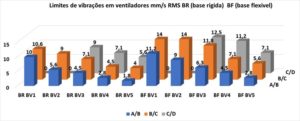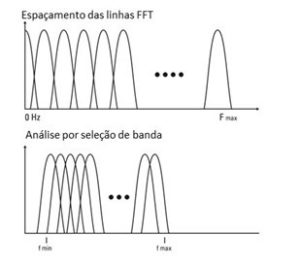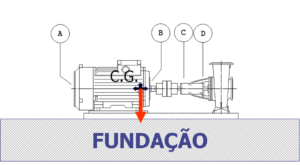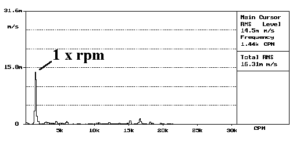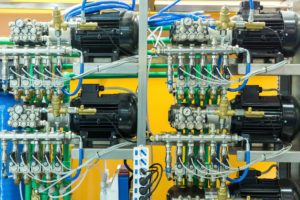Envelope and low rotation speed
1 – ENVELOPE AND LOW ROTATION SPEED – INTRODUCTION
In this article, the specific characteristics of the implementation of the envelope and low rotation speed.
The detection of faults in bearings rotating at low rotational speeds is a frequent need in maintenance programs. predictive maintenance. The limitations of traditional approaches to vibration analysis common vibration analyzer The limitations of traditional approaches to, but misunderstood.
effectively, when you want to correctly measure the amplitude of impact peaks, the main parameter to take into account is the sampling frequency of the waveform and not the maximum frequency of the spectrum.
2 – ENVELOPE AND LOW ROTATION SPEED – IMPACTS AND SIGNAL ANALYSIS
The bearing damage arise in terms of vibrations on how well evident in the waveform shocks.

these impulses, of very short duration, are well detected with a peak detector vibration meter.
1ª Rule - To follow the evolution of impact peaks it is necessary to correctly measure the peak amplitude of the waveform
Let's imagine that a bearing to rotate at low speed we want to measure a spectrum up 100 Hz. For this, typically, the analog-digital converter of a spectrum analyzer will get a waveform sampled the 2,56 x 100 Hz = 256 Hz, that is, the waveform will consist of samples obtained from 4 in 4 ms, which is completely insufficient to adequately measure the peak amplitude of the shocks. In the following figure one can see an example of a waveform with an insufficient number of samples and that its scope is not adequately characterized.

To adequately characterize a shock that lasts less than one millisecond have to take at least 10 samples per millisecond, for example. therefore we have, in order to properly characterize the amplitude of a pulse which is last one second will require a sampling frequency 10 KHz , which corresponds to a maximum frequency of the spectrum 4 KHz.
2ª Rule - Even if the bearing has a low rotation speed, the frequency scale must be high
If this rule is not followed amplitude which appears on the waveform and the spectrum is not real.
Now, in a bearing with a low rotational speed the defect frequencies are in the order of a few Hz and it is therefore necessary to obtain high resolution spectra, with a high number of lines, such as e.g. 3200.
3ª Rule - To see the characteristic frequencies of defects, high resolution spectra must be used
All that referred to the frequency spectrum analysis is also valid for the envelope analysis.
As it is known, to adequately characterize the vibrations of the bearings should be removed from the other first low frequency vibrations on the machine. This is usually done by envelope analysis..
3 – ENVELOPE AND LOW ROTATION SPEED – ENVELOPE ANALYSIS
This is the traditional scheme envelope analysis.

What is intended is what you can see below.
a) Shape before the high pass filter.
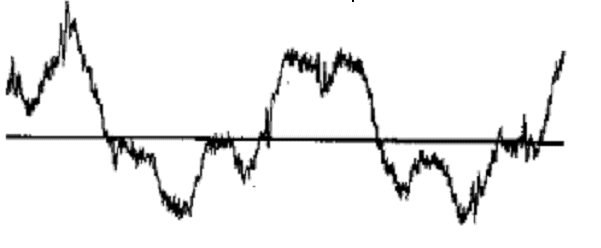
b) Waveform after filter.

c) Signal after rectification (red).
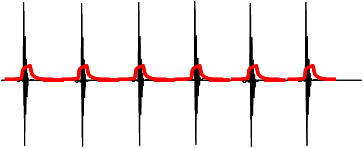
In the analog-digital conversion limitations are the same as in the analysis of the traditional spectrum.
4 – A AMPLITUDE DO ENVELOPE
The original envelope cannot accurately measure the amplitude of very short duration events.

Commonly used analog filters have a delay in response time which prevents them from taking accurate pulse measurements..
This is why many manufacturers inform the amplitude envelope of the spectral components is unreliable, and this can only be used for diagnostic purposes.
Since then measuring the peak amplitude of the envelope waveform?
Is there any way to have an envelope spectrum with correct amplitude components?
5 – CORRECT MEASUREMENT OF THE PEAK AMPLITUDE OF THE ENVELOPE WAVEFORM
There are two ways to correctly measure the envelope waveform amplitude.:
A traditional; using a peak amplitude detector. Measurements of the peak amplitude of the waveform give correct results, but the amplitude of spectral components is not.
The most recent; first sampling the waveform at a high frequency (for example 100 KHz), regardless of the maximum spectrum frequency, to ensure that it correctly detects the extent of the impact of peaks. Then these samples are used to reconstruct a waveform that will serve the construction of the frequency spectrum. In this reconstructed waveform, each sample retains the highest value of the sample set from which it originated..
Below follows a block diagram thereby envelope analysis.

With this approach the amplitude of the peaks in the waveform and the components of the spectrum, presented, is the correct.

6 – ENVELOPE AND LOW ROTATION SPEED – CONCLUSION
The limitations of traditional approaches to, The limitations of traditional approaches to measuring vibrations, The limitations of traditional approaches to.

